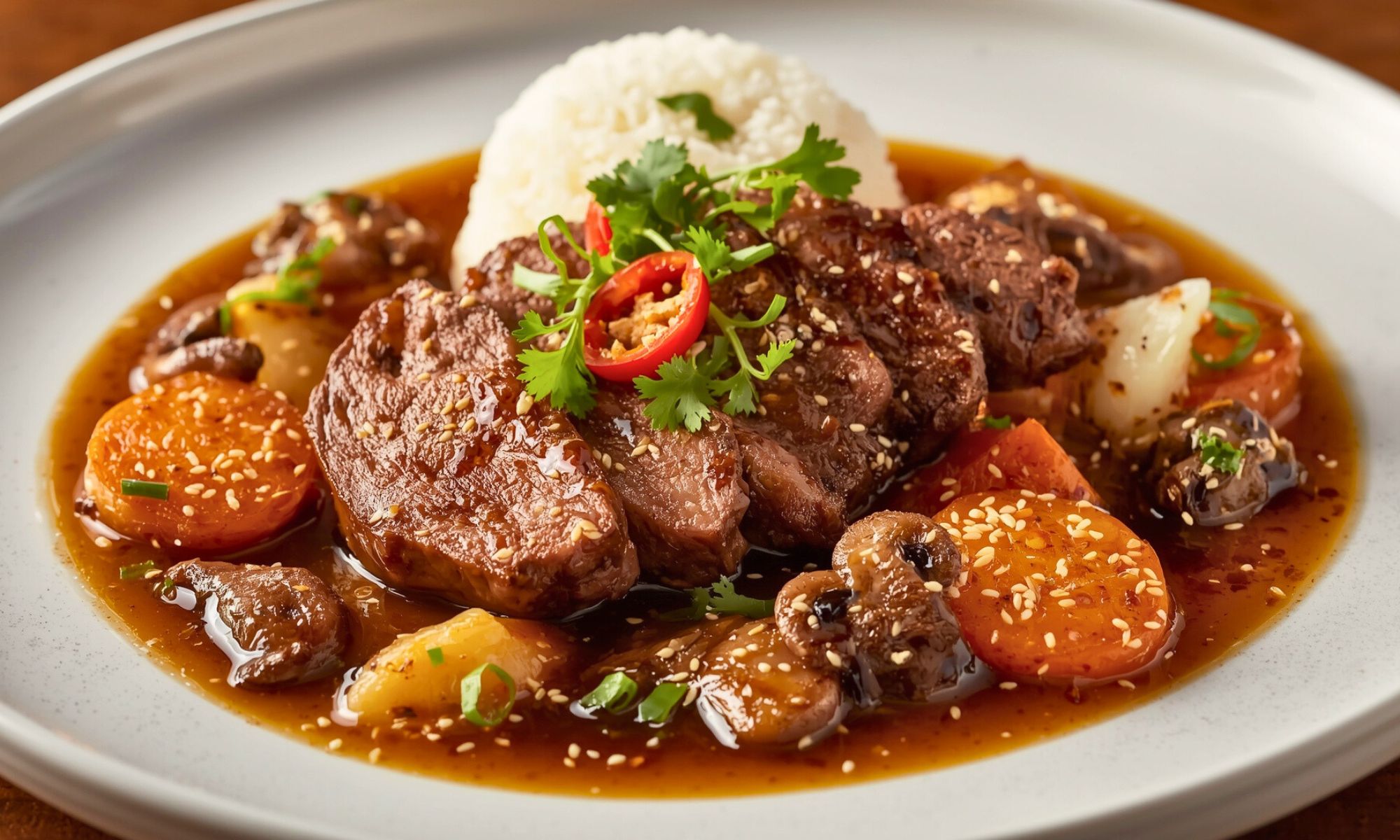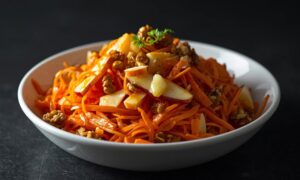Your dinner table just became the hottest reservation in town. While your neighbors scroll through delivery apps, you’re creating restaurant quality magic with ingredients that’ve been sitting in your pantry. This Korean inspired pot roast transforms Sunday meal prep into something your Instagram followers will actually envy.
Forget everything you know about traditional pot roast. We’re hijacking that comfort food classic and giving it a K-town makeover that’ll have your taste buds questioning everything. This Korean inspired pot roast combines the fall apart tenderness you crave with flavors that dance between sweet, savory, and just enough heat to keep things interesting.
I discovered this game changer during a particularly uninspired week last winter. Had some gochujang collecting dust, a chuck roast begging for attention, and zero motivation for anything complicated. What emerged from my Dutch oven that night completely rewrote my comfort food playbook.
Why This Korean Inspired Pot Roast Changes Everything
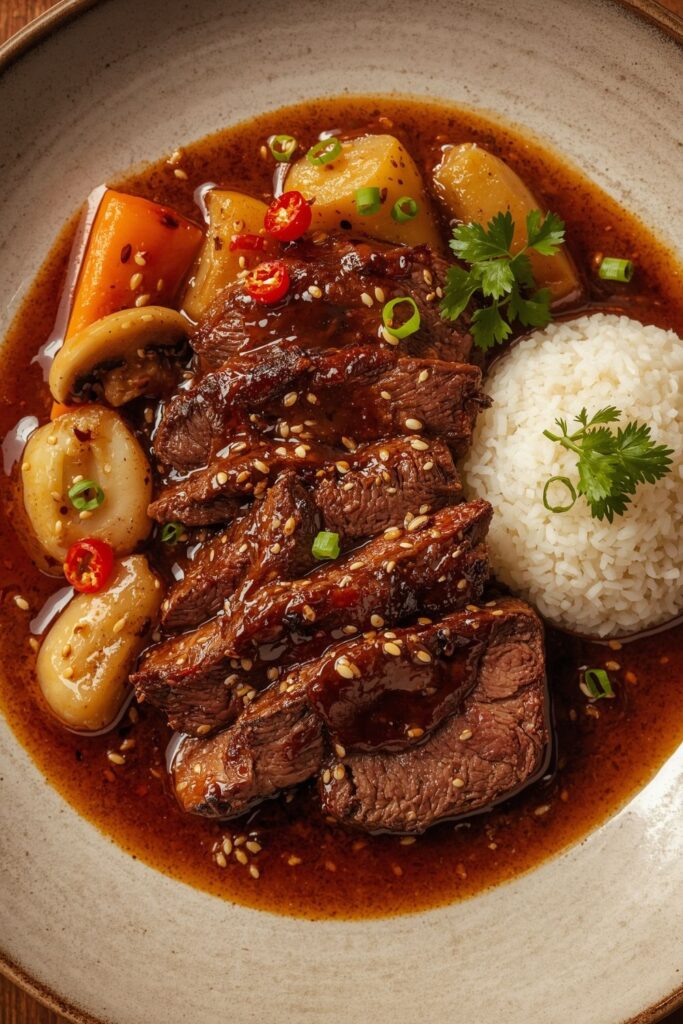
Traditional pot roast whispers. This version absolutely sings.
We’re taking everything beloved about slow braised beef and amplifying it with Korean pantry staples that most people already own. The magic happens when gochujang meets chuck roast in a long, slow dance that creates layers of complexity you didn’t know were possible.
This isn’t fusion for fusion’s sake. Korean flavors naturally complement beef’s richness while adding dimensions that make every bite revelatory. The fermented depth of gochujang, the umami punch of soy sauce, and the subtle sweetness of mirin create harmony that traditional pot roast simply can’t match.
Your kitchen becomes a sanctuary of incredible aromas. Your dinner guests become converts. Your meal prep game levels up permanently.
Essential Ingredients & Strategic Swaps
The Foundation
Protein Power:
- 3-4 lb chuck roast, cut into generous chunks
- 2 tablespoons neutral oil (vegetable or canola)
- Kosher salt and fresh cracked pepper
Flavor Architecture:
- 1 large yellow onion, thick sliced
- 8 garlic cloves, roughly chopped
- 3-inch piece fresh ginger, grated fine
- 4 tablespoons gochujang (non negotiable for authentic flavor)
- 1/3 cup low sodium soy sauce
- 3 tablespoons mirin
- 2 tablespoons dark brown sugar
- 2.5 cups rich beef stock
Supporting Cast:
- 1.5 lbs baby potatoes, halved lengthwise
- 4 large carrots, cut into thick coins
- 10 oz shiitake mushrooms, stems discarded
- 4 green onions, sliced thin
- 2 tablespoons toasted sesame seeds
- 1 tablespoon sesame oil for finishing
Smart Substitutions That Actually Work
Can’t source gochujang? Blend sriracha with white miso and brown sugar. Mix 3 tablespoons sriracha, 1 tablespoon miso, 1 teaspoon brown sugar.
Fresh ginger matters immensely here. Powdered ginger lacks the bright, zingy bite that makes Korean inspired pot roast special. If you’re stuck, use triple the amount of ground ginger.
No mirin available? Rice vinegar with sugar works. Use 2 tablespoons rice vinegar plus 1 tablespoon sugar.
Shiitakes elevate this dish significantly, but cremini mushrooms substitute adequately. The earthy depth won’t be identical, but the results remain delicious.
Chuck roast works best because fat content keeps meat moist during extended braising. Short ribs create even richer results if you’re feeling indulgent.
Step by Step Korean Inspired Pot Roast Mastery
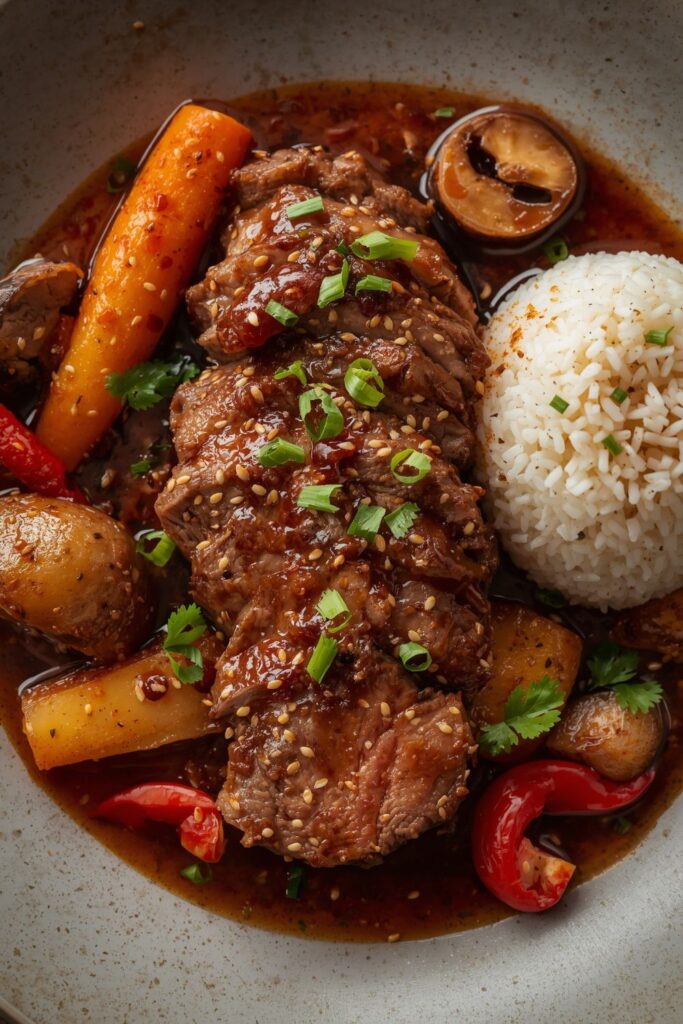
Prep Work That Sets You Up for Success
Pat chuck roast completely dry using paper towels. Moisture prevents proper browning, and we need those caramelized edges for maximum flavor development. Season aggressively with salt and pepper on all surfaces.
Prep all vegetables before starting. Once cooking begins, timing matters and you won’t want to stop mid process for chopping.
Choose your heaviest Dutch oven. Cast iron or enameled cast iron distributes heat evenly and prevents hot spots that can burn your sauce.
Creating the Perfect Sear
Heat Dutch oven over medium high heat until properly hot. Add oil when pan shimmers but doesn’t smoke. This indicates optimal searing temperature.
Brown chuck roast chunks in batches, never crowding. Each piece needs space to develop proper caramelization. Turn pieces only when they release easily from pan bottom.
This step takes patience but builds flavor foundation. Properly seared meat creates hundreds of new flavor compounds through Maillard reaction chemistry.
Remove browned meat to large plate. Don’t clean the pan – those browned bits become sauce gold.
Building Complex Flavor Layers
Reduce heat to medium. Add sliced onions to same pot with accumulated drippings. Cook 6-8 minutes until edges turn golden and translucent.
Add chopped garlic and grated ginger. Stir constantly for 45 seconds maximum. These aromatics burn quickly and turn bitter if overcooked.
Stir in gochujang and cook 90 seconds. This blooming process activates complex fermented flavors that make Korean inspired pot roast extraordinary.
Add soy sauce, mirin, and brown sugar. Stir until sugar dissolves completely, about 2 minutes.
The Long, Slow Transformation
Pour beef stock slowly while scraping up browned bits. These caramelized deposits contain concentrated flavors essential for rich sauce development.
Return seared meat to pot. Liquid should cover meat by three quarters. Add more stock if needed, but don’t completely submerge.
Bring mixture to gentle simmer over medium heat. Cover tightly and reduce heat to low. Maintain barely perceptible bubbling throughout cooking process.
Cook undisturbed for 2 hours. Resist urge to lift lid frequently – escaping steam extends cooking time unnecessarily.
Vegetable Timing and Technique
After 2 hours, test meat tenderness with fork. Meat should yield slightly but not completely fall apart yet.
Add halved potatoes and carrot coins. These sturdy vegetables need substantial cooking time but shouldn’t become mushy.
Continue covered cooking for 45 minutes more. Check liquid levels and add stock if mixture seems dry.
Add shiitake mushrooms during final 20 minutes. Mushrooms cook quickly and become tough if overcooked.
Final Touches and Flavor Balancing
Remove lid and taste sauce carefully. Adjust seasoning with additional soy sauce, brown sugar, or salt as needed.
Meat should shred easily with gentle fork pressure. If still tough, continue cooking in 15-minute intervals.
Stir in sesame oil just before serving. This finishing oil adds aromatic depth that heat would destroy.
Garnish with sliced green onions and toasted sesame seeds for color contrast and textural interest.
The Science Behind Korean Inspired Pot Roast Success
Chuck roast contains abundant collagen and connective tissue. Long, slow braising transforms tough collagen into silky gelatin, creating that coveted fall apart texture.
Gochujang brings more than heat. Fermentation creates complex glutamates that enhance savory flavors naturally. These compounds develop further during extended cooking.
Initial searing triggers Maillard reactions between proteins and sugars. This chemical process generates hundreds of flavor compounds impossible to achieve through other cooking methods.
Low temperature braising keeps muscle proteins from contracting violently. Gentle heat allows tough fibers to break down gradually while maintaining moisture.
Korean flavor profiles complement beef beautifully because they balance richness with acidity and heat. Mirin adds subtle sweetness while soy sauce provides essential umami depth.
Presentation and Perfect Pairings
Making It Instagram Worthy
Serve Korean inspired pot roast in shallow bowls to showcase beautiful sauce. The glossy, mahogany colored liquid deserves center stage attention.
Fresh green onion slices provide essential color contrast against rich brown sauce. Scatter toasted sesame seeds for additional visual interest and nutty flavor.
Arrange vegetables artfully around tender meat chunks. Baby potatoes and carrots should look purposefully placed, not randomly dumped.
Complementary Sides and Beverages
Steamed jasmine rice absorbs incredible sauce beautifully. The neutral grain balances bold Korean flavors without competing.
Quick pickled cucumber salad cuts through richness perfectly. Combine thin cucumber slices with rice vinegar, sugar, and red pepper flakes.
For wine pairings, choose medium bodied reds like Pinot Noir or Côtes du Rhône. Fruit forward wines complement sweet savory balance without overwhelming delicate spice levels.
Korean style coleslaw made with sesame oil dressing adds refreshing crunch. Combine shredded cabbage, carrots, and green onions with sesame oil, rice vinegar, and a touch of gochujang.
Advanced Variations and Creative Adaptations
Slow Cooker Conversion
Brown meat and aromatics in skillet first. Transfer everything to slow cooker and cook on low 6-8 hours.
Add vegetables during final 2 hours to prevent overcooking. Potatoes and carrots become mushy if cooked too long.
Reduce sauce on stovetop after cooking if consistency seems thin. Pour liquid into saucepan and simmer until thickened.
Spice Level Modifications
Double gochujang for serious heat lovers. Start conservatively and add more during final seasoning adjustment.
Add sliced fresh chilies during vegetable cooking stage for extra fire. Remove seeds for milder heat levels.
For mild versions, reduce gochujang to 2 tablespoons and add extra brown sugar to balance remaining heat.
Protein Alternatives
Pork shoulder works exceptionally well with Korean flavors. Adjust cooking time based on size of chunks.
Lamb shoulder creates unique flavor combinations. Increase garlic and ginger slightly to complement stronger meat flavors.
Boneless short ribs provide incredible richness but increase cooking time by 30-45 minutes.
Storage, Reheating, and Meal Prep Mastery
Korean inspired pot roast improves dramatically overnight. Flavors meld and deepen during refrigerator storage.
Store in original cooking liquid to maintain moisture. Separate portions into meal prep containers with sauce distributed evenly.
Reheat gently on stovetop over low heat. Add splash of beef stock if mixture seems dry after refrigeration.
Freeze portions for up to 4 months. Vegetables may soften slightly, but meat and sauce freeze beautifully.
For meal prep success, cook rice separately and store in different containers. This prevents rice from absorbing too much sauce during storage.
Troubleshooting Common Challenges
Meat Stays Tough
Extend cooking time in 30-minute intervals. Some cuts require longer braising than others.
Check liquid levels frequently. Insufficient moisture prevents proper collagen breakdown.
Maintain consistent low temperature. High heat toughens proteins instead of breaking them down.
Sauce Too Thin
Remove lid during final 30 minutes to encourage evaporation. Natural reduction concentrates flavors.
Mix 2 tablespoons cornstarch with cold water. Stir slurry into simmering sauce until thickened.
Strain sauce and reduce separately in saucepan over medium heat.
Vegetables Overcooked
Add sturdy vegetables later in cooking process. Potatoes and carrots need less time than meat.
Cut vegetables larger to prevent complete breakdown during extended cooking.
Remove vegetables when tender and return just before serving.
Why This Korean Inspired Pot Roast Deserves Your Attention
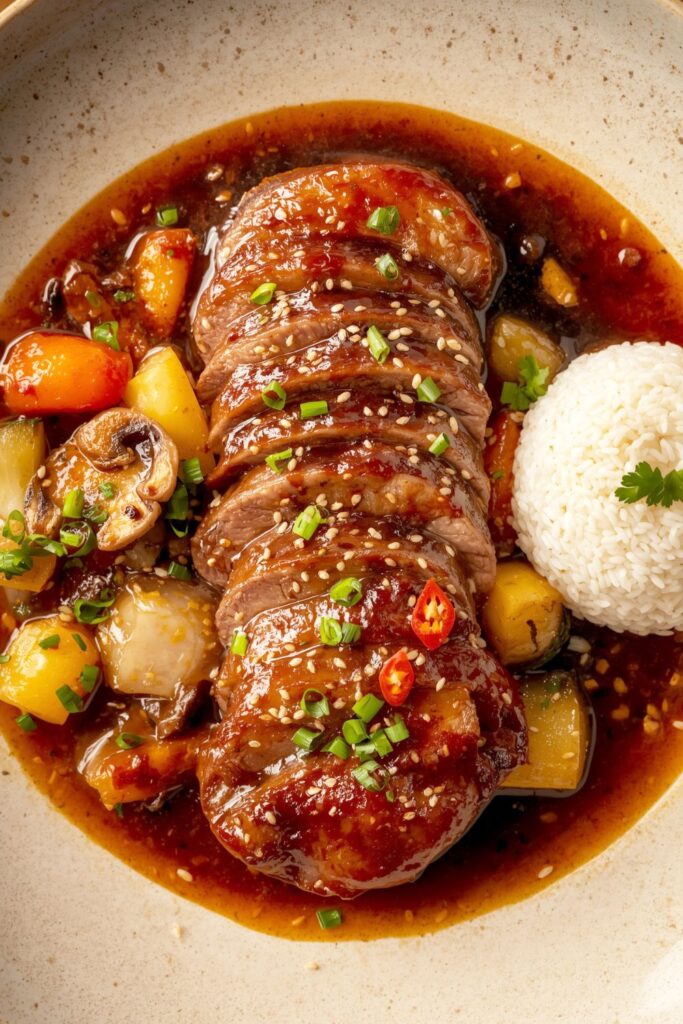
This dish represents everything great about modern home cooking. Traditional techniques meet global flavors, creating something both familiar and exciting.
The hands off cooking method fits perfectly into busy lifestyles. Minimal active time produces maximum flavor impact with ingredients readily available at most grocery stores.
Korean inspired pot roast proves that comfort food doesn’t need boring. By borrowing from Korean pantry staples, we’ve elevated humble chuck roast into something genuinely special.
Your dinner table becomes the neighborhood destination when this recipe enters regular rotation. The incredible aromas alone guarantee curious neighbors and enthusiastic recipe requests.
Frequently Asked Questions
Can I make this Korean inspired pot roast in an Instant Pot?
Absolutely! Use sauté function to brown meat and build flavor base. Pressure cook on high 90 minutes with natural release. Add vegetables during final 15 minutes using quick pressure release between additions. This method delivers faster results while still giving you incredible tenderness and flavor balance.
How spicy is Korean inspired pot roast for sensitive palates?
Gochujang provides complex heat that builds gradually rather than immediate fire. Most people comfortable with mild salsa handle this dish easily. Start with less gochujang and adjust to taste preferences. The gentle heat mingles beautifully with sweetness and umami, creating a balanced, approachable flavor experience.
What’s the best cut of beef for Korean inspired pot roast?
Chuck roast remains the gold standard because abundant marbling and connective tissue create perfect braised texture. Short ribs work wonderfully but increase cost significantly. Avoid lean cuts that dry out during long cooking. Richer cuts reward patience with luxurious results, making every bite incredibly satisfying and comforting.
Can Korean inspired pot roast be prepared completely ahead of time?
This dish actually improves after overnight refrigeration. Flavors develop complexity while resting. Reheat gently and adjust seasoning before serving. Make it 1-2 days ahead for entertaining success. The flavors deepen beautifully, ensuring your guests enjoy maximum richness with minimal last minute kitchen stress.
How do I store leftover Korean inspired pot roast properly?
Refrigerate up to 5 days in original cooking liquid. Freeze portions up to 4 months. Reheat slowly over low heat, adding stock if needed. Vegetables soften slightly after freezing but flavors remain excellent. Stored properly, this dish guarantees comforting, ready to enjoy meals long after the initial feast.
Final Thoughts
Cooking a Korean Inspired Pot Roast isn’t just about putting dinner on the table, it’s about creating an experience that feels comforting yet fresh every single time. What began for me as a simple experiment with a jar of gochujang turned into one of my most cherished kitchen discoveries. This dish takes the cozy familiarity of slow braised beef and infuses it with the bold, layered flavors of Korean cuisine, proving that comfort food doesn’t have to be predictable.
Whether you’re serving it on a quiet Sunday evening, prepping ahead for busy weeknights, or setting down a platter in front of guests, this recipe has a way of making the moment feel special. The aroma alone will draw people to the table, and the flavors will keep them asking for seconds.
So the next time you find yourself reaching for a classic recipe, let this Korean Inspired Pot Roast remind you that small changes, like adding gochujang, fresh ginger, and sesame oil, can completely transform a meal into something unforgettable. My hope is that this dish becomes as much of a favorite in your kitchen as it has in mine

Swiftly Captions by Tina Smith — Quick, flavorful food recipes made simple, bringing fresh inspiration to your kitchen every day
